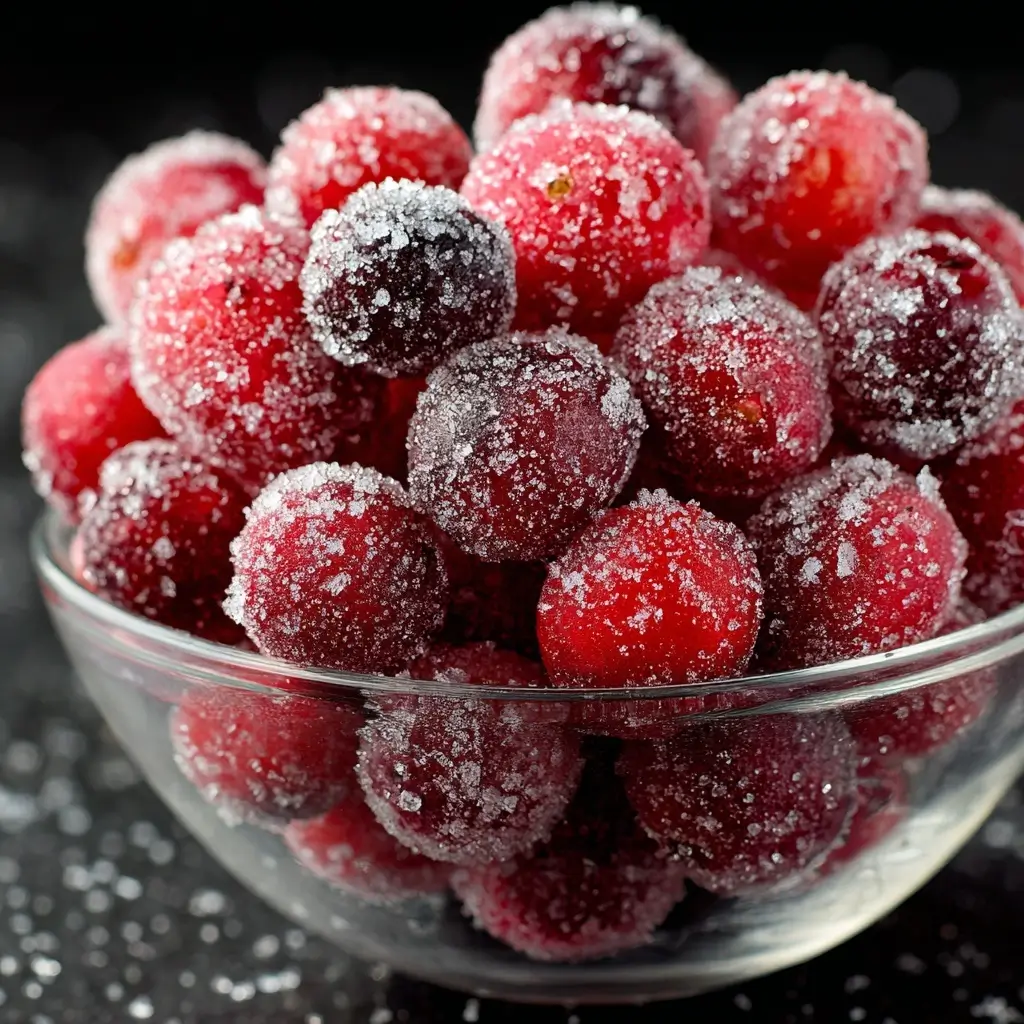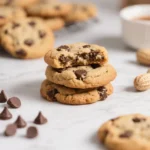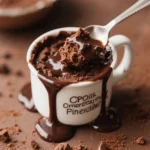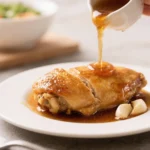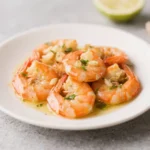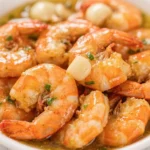Sugared Cranberries: A Festive, Sparkling Delight
Crisp, tart cranberries enveloped in a delicate shell of shimmering sugar—sugared cranberries are more than just a holiday treat; they’re edible jewels perfect for garnishing desserts, cocktails, and cheese boards. With their glossy appearance and sweet-tart flavor, these candied berries bring a festive flair to any occasion. Whether you’re preparing for Thanksgiving, Christmas, or simply elevating your dessert game, sugared cranberries offer both elegance and simplicity. This comprehensive guide walks you through everything you need to know about this delightful confection—from its historical roots to the science behind the sugar coating, detailed recipe instructions, variations, nutritional insights, and expert tips to ensure perfection every time.
The History of Sugared Fruits and Berries
The tradition of preserving fruits in sugar dates back centuries, with origins rooted in ancient Persia and medieval Europe. Before refrigeration, preserving fruits was essential for extending shelf life and enjoying seasonal produce year-round. Candying fruit became an art form during the Renaissance, especially in Italy and France, where it was served as a delicacy among royalty. Chefs would slowly cook fruits in sugar syrups until they were translucent and then dry them to create a crystallized finish.
While sugared cranberries themselves may not have a documented lineage stretching back hundreds of years (given that cranberries are native to North America), the practice of candying berries follows this broader culinary tradition. Native Americans used cranberries for food, dyes, and medicine long before European settlers arrived. When colonists began incorporating cranberries into their diets, they discovered the berry’s natural tartness balanced beautifully with sugar. Over time, creative cooks began experimenting with whole cranberries, leading to treats like sugared cranberries—especially popular during the winter holidays when fresh, vibrant colors are cherished.
Today, sugared cranberries are a staple on holiday tables, often featured in upscale bakeries, gourmet gift baskets, and festive cocktail recipes. Their jewel-like sparkle makes them ideal for decoration, while their burst of flavor adds complexity to sweet and savory dishes alike.
Ingredients Breakdown: What Makes Sugared Cranberries Shine?
The magic of sugared cranberries lies in the quality and interaction of just a few simple ingredients. Let’s take a closer look at each component and why it matters:
- Fresh Cranberries: The star of the show. Choose plump, firm, bright red cranberries. Avoid soft, shriveled, or discolored ones. Freshness ensures the berries hold their shape during the sugar-coating process and retain their signature pop when bitten.
- Granulated Sugar: Used in two stages—first in the syrup to coat the berries and later as a drying layer. Fine granulated sugar dissolves easily and creates a smooth, even glaze. Superfine sugar can be used for an extra-delicate finish.
- Water: Acts as the medium to dissolve sugar and create the syrup. The ratio of sugar to water is crucial—it must be saturated enough to form a sticky coating without boiling down too much and caramelizing.
- Egg White (optional but recommended): A small amount of beaten egg white helps the sugar adhere better, creating a thicker, more uniform sparkle. It acts as a natural binder and is commonly used in confectionery for achieving a professional look.
- Additional Flavorings (optional): A splash of vanilla extract, orange zest, or cinnamon can enhance the flavor profile. Some bakers also use flavored sugars (like lavender or rose-infused sugar) for a gourmet twist.
Each ingredient plays a functional role—not just in taste, but in texture and appearance. The balance between acidity from the cranberry and sweetness from the sugar creates a harmonious flavor, while the method ensures a crisp, glassy exterior.
Step-by-Step Recipe: How to Make Perfect Sugared Cranberries at Home
Making sugared cranberries is surprisingly easy and requires no special equipment. Follow these detailed steps for flawless results every time.
Ingredients
- 1 cup fresh cranberries
- 1/2 cup granulated sugar (plus 1/2 cup for coating)
- 1/4 cup water
- 1 large egg white
- 1/2 teaspoon pure vanilla extract (optional)
- Zest of 1 orange (optional)
Directions
- Prepare the Cranberries: Rinse the cranberries under cold water and pick out any stems, leaves, or soft berries. Spread them on a clean kitchen towel or paper towels and pat dry thoroughly. Moisture is the enemy of proper sugar adhesion, so ensure they are completely dry.
- Make the Sugar Syrup: In a small saucepan, combine 1/2 cup sugar and 1/4 cup water. Heat over medium heat, stirring gently until the sugar dissolves completely. Bring to a gentle simmer and let it cook for 1–2 minutes until the syrup becomes slightly sticky. Do not boil vigorously or allow it to caramelize.
- Coat the Cranberries: Remove the syrup from heat and carefully add the cranberries. Gently stir using a silicone spatula or wooden spoon to coat each berry evenly. Be careful not to crush them. Let the cranberries sit in the warm syrup for 5–7 minutes to absorb some sweetness and soften slightly.
- Drain and Cool: Using a slotted spoon, transfer the coated cranberries to a wire rack placed over a baking sheet (to catch drips). Allow them to cool and set for about 10 minutes until the syrup begins to harden.
- Prepare the Egg White Wash (Optional but Recommended): In a small bowl, lightly beat the egg white until frothy. Add vanilla or citrus zest if desired. Dip each cooled cranberry into the egg white mixture, ensuring full coverage, then immediately roll it in the remaining 1/2 cup of granulated sugar.
- Roll in Sugar: Place the second 1/2 cup of sugar on a shallow plate. After dipping in egg white, roll each cranberry gently until fully coated. Return them to the wire rack and let them air-dry for 1–2 hours at room temperature. For faster drying, place in front of a fan or in a cool oven with the light on.
- Store or Serve: Once completely dry and crisp, sugared cranberries can be stored in an airtight container with parchment layers or used immediately as garnishes.
Yield: Approximately 1 cup
Prep Time: 15 minutes | Cooking Time: 5 minutes | Drying Time: 1–2 hours
Tips for Success: Expert Advice for Flawless Sugared Cranberries
To elevate your sugared cranberries from good to spectacular, consider these professional tips:
- Dry Berries Thoroughly: Any moisture will prevent sugar from sticking properly. Pat dry and let air-dry for 10 minutes after rinsing.
- Don’t Overcook the Syrup: The syrup should dissolve sugar completely and become slightly viscous, but not turn golden or caramelized. High heat can break down the cranberries’ structure.
- Use a Wire Rack: Elevating the berries allows air circulation, preventing flat spots and ensuring even drying.
- Work in Batches: If making a large quantity, work in small batches to maintain consistency and avoid overcrowding.
- Add Color Variations: Toss dried sugared cranberries in edible luster dust (gold, silver, red) for extra glamour at holiday parties.
- Chill Before Serving (Optional): Refrigerating them briefly firms up the sugar shell and enhances the crunch.
- Avoid Humidity: High humidity can cause sugar to dissolve or become sticky. Make them on dry days or use a dehumidifier if necessary.
- Test One Berry First: Before committing to a full batch, test the process with a few berries to adjust sugar thickness or drying time.
Variations and Customizations: Make It Your Own
Sugared cranberries are incredibly versatile. Here are creative ways to customize them for different occasions and palates:
- Flavored Sugars: Roll the cranberries in spiced sugar (cinnamon + sugar), citrus sugar (lemon or orange zest mixed with sugar), or even chili-lime sugar for a sweet-heat kick.
- Chocolate-Dipped: After sugaring, dip one end in melted dark, milk, or white chocolate and let harden on parchment paper.
- Gilded Cranberries: Brush with edible gold leaf or spray with edible metallic spray for luxurious holiday decor.
- Herb-Infused: Add crushed rosemary, thyme, or lavender to the sugar syrup for an aromatic twist—perfect for cheese platters.
- Gluten-Free & Vegan Option: Replace egg white with aquafaba (the liquid from a can of chickpeas). Whip it slightly for better adhesion.
- Mini Skewers: Thread sugared cranberries onto toothpicks with marshmallows or small cookies for festive party picks.
- Liqueur-Infused: Add a tablespoon of Grand Marnier, Chambord, or brandy to the syrup for a boozy depth of flavor.
- Layered Sugars: Roll first in coarse sugar, then in colored sanding sugar for a multi-textured sparkle.
Health Considerations and Nutritional Value
While undeniably delicious, sugared cranberries are a treat best enjoyed in moderation. Here’s a breakdown of their nutritional aspects:
Nutritional Highlights (per 1/4 cup serving):
- Calories: ~120–150 kcal
- Total Sugar: ~30g (mostly added sugar)
- Dietary Fiber: 2–3g (from cranberries)
- Vitamin C: Significant amount (cranberries are naturally rich in vitamin C)
- Antioxidants: Cranberries contain polyphenols and flavonoids known for anti-inflammatory and heart-protective properties.
Health Considerations:
- High Sugar Content: Due to the double coating (syrup and rolling sugar), these are high in added sugars. Diabetics or those managing blood sugar should consume sparingly.
- Dental Health: Sticky, sugary foods can contribute to tooth decay. Rinse mouth or brush teeth after consumption.
- Portion Control: Use as a garnish rather than a snack to enjoy flavor without overindulgence.
- Egg Safety: If using raw egg white, opt for pasteurized eggs or egg whites to reduce salmonella risk, especially for pregnant individuals or immunocompromised persons.
- Allergens: Contains egg (if used); otherwise, naturally gluten-free and dairy-free.
On the positive side, cranberries themselves are low in calories and packed with nutrients. They’re known for supporting urinary tract health due to proanthocyanidins that prevent bacterial adhesion. However, the benefits are somewhat offset by the sugar load in this preparation.
Frequently Asked Questions (FAQ)
Q: How long do sugared cranberries last?
A: Stored in an airtight container in a cool, dry place, they last 5–7 days. In the refrigerator, they can keep for up to 10 days, though the sugar may absorb moisture and become sticky.
Q: Can I freeze sugared cranberries?
A: Not recommended. Freezing can cause condensation upon thawing, which dissolves the sugar coating and makes them soggy.
Q: Why did my sugar not stick?
A: Likely causes include wet berries, insufficient egg white, or sugar that wasn’t fine enough. Ensure all surfaces are dry and use superfine sugar if needed.
Q: Can I make them without egg white?
A: Yes, but the sugar coating may be thinner and less durable. The syrup-only method works, but the sparkle won’t be as pronounced.
Q: Are sugared cranberries safe for kids?
A: Yes, but supervise young children due to choking hazard. Also, limit portions because of high sugar content.
Q: Can I use frozen cranberries?
A: Possible, but not ideal. Thaw and dry thoroughly—frozen berries tend to be softer and may break during handling.
Q: What can I use sugared cranberries for?
A: Garnish cakes, cupcakes, tarts, pavlovas; float in cocktails (like champagne or cranberry mimosas); decorate holiday platters; add to gift jars or DIY dessert kits.
Summary
Sugared cranberries are a dazzling, easy-to-make confection that combines the natural tartness of cranberries with a sparkling sugar crust, perfect for holiday entertaining and gourmet gifting. With minimal ingredients and maximum visual impact, they transform ordinary desserts into extraordinary delights.
